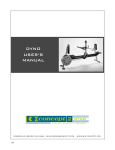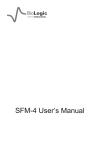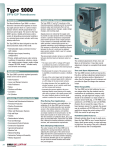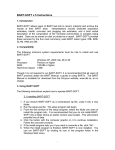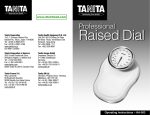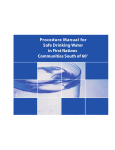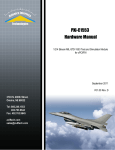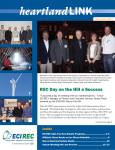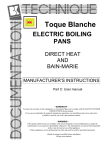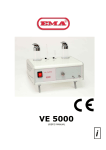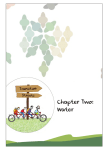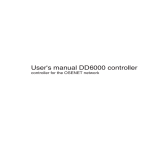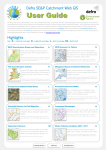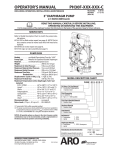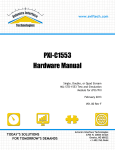Download Water Quality Report - Clearbrook Waterworks District
Transcript
CLEARBROOK WATERWORKS DISTRICT Water Quality Report For the period of January 1 – December 31 2013 2564 Clearbrook Road, Abbotsford, B.C. V2T 2Y5 Gold Medal Winner of the Best Tasting Municipal Tap Water in the World 2008, 2009 For further information regarding this report please contact: Carla Grunwald Phone: 604-850-6621 Fax: 604-850-7862 Email: [email protected] Dear Rate Payers: CWD’s water system supplies, distributes and stores potable water to about 14,800.00 water users in the District. We take enormous pride in providing the highest quality drinking water at a reasonable cost, meeting water demands, complying with provincial regulations and working responsibly to protect the aquifer. On an average day CWD delivers 2.9 million liters of high quality water through thirty-two (32) kilometers of piping. The average monthly groundwater withdrawal for 2013 was 88.1 million liters. Our drinking water is pumped out of the Abbotsford-Sumas Aquifer by three high-capacity wells, operating at a discharge rate between 44 and 50 liters per second (l/s) in 2013. In May 2013 a 150-mm diameter test well (with a completed depth of 40.2 m below ground surface) was constructed at Autumn Well Field to confirm hydrogeology and water quality. A water quality monitoring program is in place for this test well to confirm the water chemistry before proceeding with a replacement well (scheduled for 2014) at this well field. On August 13, 2013, Fraser Health granted the permission to CWD to commission RW 7-00/13 to supply water to CWD’s water system. The well is successfully operating in rotation with RW 3-93/11 and Well 1-87. RW 7-00/13 is a 400-mm diameter well with a total depth of 39.30 m. The estimated safe yield for this well is 57.5 l/s. For both projects, Fyfe Well & Water Services provided the well drilling, construction, well testing, and mechanical completion (pump installing) services. Kalwij Water Dynamics provided the hydrogeological and project management services. The Drinking Water Protection Act (DWPA), created by BC Ministry of Health, sets acceptable limits for compounds in drinking water that may pose a health risk. This act is enforced by all Drinking Water Health Officers in BC. As a water purveyor we are required to have our water analyzed to confirm the absence of microbiological pathogens by an approved laboratory. In this report you will find: 1) Information about Water Quality 2) CWD’s Water Quality Technician Report 3) Water Quality Review of 2013 a. Review of the potability and analysis results b. Biological Activity Reaction Test results (BART) 4) Result of the water samples analyzed by Exova Group Limited (Appendix A) 5) The results of the bacteriological water quality samples submitted to the Fraser Health Authority for 2013 (Appendix B) 6) HealthLink BC advisory on Drinking Water and Those with Weakened Immune Systems, and a “Flush” message regarding Metals in Drinking Water (Appendix C) CWD’s staff samples four of the District’s twenty six (26) sampling stations once a week on a rotating basis. In addition, once a month, a sample is collected from the reservoirs and a pumping well. We are governed by provincial legislation for water purveyors which includes the British Columbia Drinking Water Protection Act (BCDWPA) and British Columbia Drinking Water Protection Regulations (BCDWPR), and adhere to the federal Guidelines for Canadian Drinking Water Quality (GCDWQ). Potable water is essential to life; CWD is pleased to provide our 2013 Annual Water Quality Report and will gladly answer any questions that may arise. We trust the report demonstrates the commitment of our Board of Trustees and staff to service and to the primary goal of delivering high quality water which is vital to the health and well-being of every single person who lives or visits our District. Sincerely, Carla M. Grunwald CEO Information about Water Quality Pure water is tasteless and odourless, but water in a pure state is unlikely to be found in nature. The District relies 100% on groundwater which may contain a variety of compounds, including microorganisms, inorganic and organic materials. When we talk about good quality water we consider it as a combination of taste, clarity, odour and safe for consumption. The District’s pro-active approach aims to maintain the highest possible quality of water for our ratepayers. All our field crew members are certified operators and continue to attend workshops and courses to keep their certification in good standing and to be informed of the latest technology and legislation. What can I do to improve water quality? In the face of this planet's overwhelming environmental problems, each individual effort to protect water quality is vital. Together, individual actions can and do make a difference to water quality and the environment as a whole. You can start by taking the following actions: Avoid hazardous household products Most proprietary household chemicals are safe to use and are environmentally friendly when used according to the directions on the package. However, some have a harmful cumulative effect on the environment when they are over-used or incorrectly disposed of. Check the label for hazard warnings. The symbols used on hazardous household chemical products are shown below: The warning symbols are based on shape; the more corners a symbol has, the greater the risk. Read the label to find out how to use the product safely and what precautions to take. Buy only those environmentally hazardous products you really need, and buy them in quantities you will be able to completely use up, so that you will not have to worry about disposing the leftovers later. Use "environmentally friendly" products now available in your supermarket and drugstore. The federal government endorses products that are environmentally friendly. Look for the Environmental Choice EcoLogo. Products bearing this label have been tested and certified by the Canadian Standards Association. Each dove represents a sector of society – consumers, industry, and government – linked together to improve and protect the environment. The logo identifies the products that maximize energy efficiency and the use of recycled or recyclable materials and minimize the use of environmentally hazardous substances. Consumers can make informed choices. Additional information on environmentally friendly household products and their uses can be obtained from the following organization: Canadian Manufacturers of Chemical Specialties Association E-mail: [email protected] Do not misuse the sewage system Do not throw waste down the drain just because it is convenient. Toxic household products can damage the environment and return to us through water and food. toss items such as dental floss, hair, disposable diapers and plastic tampon holders into the wastebasket, not the toilet – these items create many problems at the sewage treatment plant always use up completely (or pass on for other people to use) the unused contents of oven, toilet bowl and sink drain cleaners; carpet and furniture cleaners and polishes; bleaches, rust removers and solvents; paints and glue; and most other acid and alkali products save food scraps (except dairy and meat) and compost them; do not dump them down the drain choose latex (water-based) paint instead of oil-based and use it up instead of storing or dumping it Do not use pesticides or other hazardous materials in your garden Adopt alternative pest control methods, such as: hand pulling weeds snipping and discarding infested leaves dislodging insects with insecticidal soap or a water hose practicing companion planting – for more information go to: www.companionplanting.net applying a natural insecticide such as diatomaceous earth, available in garden centers fertilize with natural materials such as bone meal or peat setting ant and roach traps instead of using chemical sprays Do not dump hazardous products into storm drains Storm drains empty directly into nearby streams in many areas. The contents of storm sewers are generally not processed at sewage treatment facilities and can therefore do immediate harm to fish and wildlife. DO NOT pour oils, paint compounds, solvents and other products into storm sewers, onto the street, or into your driveway DO take them to local recycling or disposal facilities. Take further action There is more you can do! read up on environmental issues be willing to change your attitudes, behaviour and expectations write away for more information on environmentally-friendly products and methods join and support local and national environmental groups that work to solve environmental problems; they are always in need of more volunteers and different talents attend public hearings, participate in advisory boards, address review committees, request information inform your friends and educate your children Water Quality Technician’s Report Early on in 2013, it was evident that it would be an interesting year for water quality monitoring and reporting. Well RW 7-00\13 was drilled, constructed and developed in November 2012, and was subjected to various pump and flow tests throughout spring and summer of 2013. Detailed water quality microbiological/chemical testing was completed between February and October. The well was placed into regular rotation with RW 3-93 and Well 1-87 on October 30, 2013. This well was also part of the second series of BART testing in 2013, which took place in November. We will continue to gather data from this well, and we are starting to get an understanding of what our baseline parameters are for RW 7-00\13. CWD will be entering a water sample from RW 7-00/13 in the Berkeley Springs International Water Tasting contest in February 2014. The new pump station being built at our reservoir site proved to be an interesting challenge in 2013. Work done on the new pump station included the installation, disinfection, and microbiological testing of multiple lengths of pipe, as well as multiple tie-ins. In order to simulate water demand through the pump station as is intended, a weekly flushing program was instituted to maintain water quality in the upper system. Spring flushing took place in March, and was followed by a late fall flush in November, due to the ongoing reservoir site pump station project. In May, a test well (TW13-01) was drilled at our Autumn well site, and was flushed and sampled monthly in order to determine the suitability of drilling a replacement well for Well 1-87 in the same well field. Plans to drill said replacement well are set in place for 2014. For 2014, we have revised our water sampling schedule to reflect a more comprehensive coverage of the district. Respectfully submitted, Ryan Federau Water Quality Technician Water Quality Review 2013 Potability Analysis Results Raw water samples were collected from Well 1-87, RW 3-93/11 and RW 7-00/13 on December 23, 2013. The water samples were analyzed by Exova Group Limited (Exova), an accredited laboratory located in Surrey BC, on: (1) physical properties; (2) water chemistry; and (3) bacteriology. Water sampling for Well 7-00 has been discontinued since this well is permanently off-line since July 22, 2013. Tables 1 - 4 summarize the water quality analysis data (physical parameters, metals, miscellaneous parameters, and microbiological parameters, respectively). Results are evaluated with the Guidelines for Canadian Drinking Water Quality (Health Canada 20121). Appendix A includes the original lab reports prepared by Exova. In summary, results of the water analysis suggest that the water quality meets the requirements stated in the Guidelines for Canadian Drinking Water Quality. Physical Properties pH The pH (“potential of hydrogen”) is a measure for hydrogen-ion concentration in water, and tells something about the degree of acidity or alkalinity (basicity) of water. A pH measurement less than 7.0 means that the water is acidic; a value equal to 7.0 means that the water is neutral, and a value more than 7.0 means that water is basic or alkaline. The Aesthetic Objective (AO) guideline for pH is between 6.5 and 8.5. 1 Health Canada. 2012. Guidelines for Canadian Drinking Water Quality. Summary table. Drinking Water Guidelines. Prepared by the Federal-Provincial-Territorial Committee on Drinking Water of the Federal-ProvincialTerritorial Committee on Health and the Environment (August 2012). Available at http://www.hc-sc.gc.ca. Table 1. Physical Parameters Parameter Well 1-87 pH Total dissolved solids (TDS) Electric conductivity Turbidity Colour Hardness (CaCO3) RW 3-93/11 RW 7-00/13 Canadian Drinking Water Guidelines Units Guideline comment 7.18 6.95 6.83 6.5 - 8.5 --- within AO 138 164 140 500 mg/l below AO 209 256 210 - 0.1 < NDL 0.1 - NTU < NDL < NDL < NDL 5 Colour units 84 104 87 - mg/l μS/cm at 25 o C no guideline set no guideline set no guideline set AO = Aesthetic Objective. The pH values (Table 1) for Well 1-87, RW 3-93/11 and RW 7-00/13 are 7.18, 6.95, and 6.83, respectively suggesting that the water is alkaline for Well 1-87 and acidic for RW 3-93/11 and RW 7-00/13. The sampled water meets the AO guideline. The values suggest that there is no concern of corrosion or encrustation. A pH value between 6.8 to 7.3 is an ideal condition with respect to inhibition of corrosion and incrustation (Health Canada 19792). Total Dissolved Solids Total Dissolved Solids (TDS) is the total amount of materials dissolved (mineral constituents) in water, computed from conductivity and turbidity. High levels of TDS can cause hardness, unpalatability, mineral deposition and corrosion. At low levels, however, TDS contributes to the palatability of water (Health Canada 1978 3). TDS and the Electrical Conductivity (EC) are in close connection. (The more salts are dissolved in the water the higher the value of the electric conductivity is.) TDS values (Table 1) for Well 1-87, RW 3-93/11, and RW 7-00/13 are 138, 164, and 140 milligrams per litre (mg/l), respectively, and are below the Maximum Allowable Concentration (MAC) limit of 500 mg/l. Turbidity Turbidity is a measure of the relative clarity of water, and turbidity in water is caused by suspended and colloidal matter (fine sand, clay, silt, organic and inorganic matter, and Health Canada (1979) pH - Technical Document, May 1979 (reprinted 1995). Available at: http://www.hc-sc.gc.ca. Health Canada (1978) Total Dissolved Solids (TDS) - Technical Document, September 1978 (updated January 1991). Available at: http://www.hc-sc.gc.ca. 2 3 microscopic organisms). Turbidity is also a useful indicator of groundwater quality changes. Turbidity values can be impacted by groundwater recharge events as recharging displaces sediments, especially if groundwater is under direct influence of surface water. The health-based turbidity operation guideline for water treatment plants (OG) is 0.1 Nephelometric Turbidity Units (NTU). Turbidity value (Table 1) is 0.1 NTU for Well 1-87 and RW 7-00/13. The turbidity value for RW 3-93/11 was below nominal detection limit (NDL), which is less than (<) 0.1 NTU. Hardness This parameter is an indicator for the softness or hardness of water. Soft water can have a corrosive effect, whereas hard water may result in scale deposits (incrustation in e.g. the water distribution system). MAC has not been established, but generally water with hardness greater than 200 mg/l is considered poor, and in excess of 500 mg/l is unacceptable for most domestic purposes. Hardness (Table 1) is evaluated based on the concentration of calcium carbonate (CaCO3) because calcium (Ca-2) and carbonate (CO3-2) are the dominant ions in most hard waters. CaCO3 values for Well 1-87, RW 3-93/11, and RW 7-00/13 are 84, 104, 87 mg/l, respectively, and are categorized as moderately hard (60-120 mg/l). Hardness levels between 80 and 100 mg/L (as CaCO3) are generally considered to provide an acceptable balance between corrosion and incrustation (Health Canada4). Metals Manganese Manganese is a metallic element either naturally occurring through weathering of minerals and rocks, or due to human influences entering the groundwater through leaching or effluent. The AO guideline is 0.05 mg/l. Concentrations exceeding 0.15 mg/l can stain plumbing fixtures and laundry. It can also produce undesirable tastes in beverages. Even at concentrations below 0.05 mg/l, manganese may form coatings on water distribution pipes that may slough off as black Health Canada (1979) Hardness - Technical Document, February 1979 (reprinted 1995). Available at: http://www.hc-sc.gc.ca. 4 Table 2. Total Metals Metal extractable Symbol Canadian Drinking Water Well 1-87 RW 3-93/11 RW 7-00/13 Guidelines Units Guideline comment Aluminium Al < NDL < NDL < NDL 0.1 mg/l below OG Antimony Sb < NDL < NDL < NDL 0.006 mg/l below MAC Arsenic As 0.0008 0.0003 0.0003 0.01 mg/l below MAC Barium Ba 0.012 0.007 0.006 1 mg/l below MAC Boron Ba 0.017 0.013 0.009 5 mg/l below MAC Cadmium Cd < NDL < NDL < NDL 0.005 mg/l below MAC Chronium Cr 0.0008 0.001 0.0012 0.05 mg/l below MAC Copper Cu < NDL < NDL < NDL 1 mg/l below AO Iron Fe 0.009 < NDL 0.014 0.3 mg/l below AO Lead Pb 0.0001 0.0002 0.0003 0.01 mg/l below MAC Manganese Mn 0.003 < NDL 0.001 0.05 mg/l below AO Selenium Se 0.001 < NDL < NDL 0.01 mg/l below MAC Uranium U < NDL < NDL < NDL 0.02 mg/l below MAC Vanadium V 0.0007 0.001 0.0009 - mg/l no guideline set Zinc Zn 0.007 0.015 0.018 5 mg/l below AO Calcium Ca 23.5 29.6 24.7 - mg/l no guideline set Magnesium Mg 6.3 7.28 6.05 - mg/l no guideline set Potassium K 1.7 1.5 1.2 - mg/l no guideline set Sodium Na 8.6 9.5 6.6 200 mg/l below AO Sulphur S - - - - mg/l --- Silicon Si 8.16 8.84 9.53 - mg/l --- MAC = Maximum Allowable Concentration; OG = Operational Guideline; AO = Aesthetic Objective. precipitates (Health Canada 1987 5). Presence of manganese in water may lead to microbial growth in and around the well casing and water distribution system. Manganese concentration (Table 2) for Well 1-87 was evaluated at 0.003 mg/l, and the manganese concentration for RW 3-93/11 is below NDL (< 0.001 mg/l). The manganese concentration for RW 7-00/13 is 0.001 mg/l. Iron Like manganese, iron is a metallic element either naturally occurring through weathering of minerals and rocks, or due to human influences entering the groundwater through leaching or effluent. The AO guideline is 0.3 mg/l. Similar to manganese, concentrations exceeding 0.3 mg/l can cause staining (plumbing fixtures and laundry) and can produce undesirable tastes in beverages. Precipitation of iron is visible as reddish-brown color to water and well components. Health Canada (1979) Manganese - Technical Document, May 1979 (updated November 1987). Available at: http://www.hc-sc.gc.ca. 5 Like for manganese, presence of iron may lead to the growth of unwanted bacteria (that form slime coating) in the water infrastructure. Iron concentrations (Table 2) for Well 1-87 and RW 7-00/13 are 0.009 mg/l and 0.014 mg/l, respectively, meeting the AO guideline criterion. The iron concentration for RW 3-93/11 is below NDL of 0.005 mg/l. Miscellaneous parameters Nitrogen Nitrate ( NO3 ) and nitrite ( NO2 ), both products of the oxidation of nitrogen by microorganisms in plant, soil and water, are naturally occurring ions that are ever-present in the environment. Nitrates are used widely as inorganic fertilizers. MAC levels for nitrate and nitrite are 10 mg/l and 1 mg/l, respectively. Nitrate nitrogen concentrations (Table 3) are 1.25, 1.46, and 2.33 mg/l for Well 1-87, RW 393/11 and RW 7-00/13, respectively (and thus below MAC level). Water sample results for all three wells indicate that nitrite nitrogen concentrations are below NDL of 0.01 mg/l. Fluoride Fluoride is a chemical that naturally occurs in ground water from leaching of fluoride-containing rock formations, breakdown of soils, and deposition of atmospheric volcanic particulates. Fluoride is also introduced to the water system through agricultural practices, chemical manufacturing plants, and septic and sewage systems. Health Canada has established a MAC of 1.5 mg/l for fluoride. Water samples results (Table 3) show fluoride concentration of 0.04, 0.03, and 0.02 mg/l for Well 1-87, RW 3-93/11 and RW 7-00/13, respectively (and thus below MAC level). Microbiology Total Coliforms Total coliforms are bacteria species (organisms) that are found naturally in water, soil, vegetation, and human and animal faeces. Coliforms are an indicator of the sanitary condition of the groundwater. If any colonies are detected, corrective measures must be implemented. Table 3. Miscellaneous Parameters (Inorganics, Anions and Nitrogens) Parameter Symbol / Chemical Formula Well 1-87 Canadian Drinking Water RW 3-93/11 RW 7-00/13 Guidelines Units Guideline comment Inorganics Alkalinity (total) CaCO3 Fluoride F - 64 62 46 - mg/l no guideline set 0.04 0.03 0.02 1.5 mg/l below MAC Anions Dissolved sulphate SO42− 20.9 21.2 14.7 500 mg/l below AO Dissolved chloride Cl- 11.2 27.7 22.3 250 mg/l below AO Nitrogens (N) Nitrate - N Nitrite - N NO3 NO2 − − 1.25 1.46 2.33 10.0 mg/l below MAC < NDL < NDL < NDL 1.0 mg/l below MAC MAC = Maximum Allowable Concentration; AO = Aesthetic Objective. Table 4. Microbiological Parameters Parameter Canadian Drinking Water Well 1-87 RW 3-93/11 RW 7-00/13 Guidelines Units Guideline comment Total coliform bacteria < NDL < NDL < NDL 0 CFU / 100 ml CFU / ml below MAC Escherichia coliform bacteria subgroup (E. Coli) < NDL < NDL < NDL 0 CFU / 100 ml CFU / ml below MAC MAC = Maximum Allowable Concentration. The Health Canada guideline limit for Total Coliforms is 0 MPN (Most Probable Number) per 100 millilitres (ml); i.e., none detectable per 100 ml. Water sample results (Table 4) for all three wells show total coliforms concentration values < 1 MPN/100 ml (i.e., below NDL), thereby meeting Health Canada guideline criterion for total coliforms of 0 per 100 ml. Escherichia Coliform (E.coli) E.coli is member (subgroup) of the total coliforms group but is found exclusively in faeces of humans and animals. Its presence in water indicates not only recent faecal contamination of the water but also the possible presence of intestinal disease-causing bacteria, viruses, and protozoa; the detection of E.coli should lead to the immediate issue of a boil-water-advisory and immediate corrective actions (Health Canada 20066). (Absence of this bacteria does not necessarily indicate that intestinal viruses and protozoa are also absent.) Health Canada (2006) Guidelines for Canadian Drinking Water Quality: Supporting Documentation (Total Coliforms). Prepared by the Federal-Provincial-Territorial Committee on Drinking Water of the Federal-ProvincialTerritorial Committee on Health and the Environment Ottawa, Ontario. Available at http://www.hc-sc.gc.ca. 6 The guideline limit for E.coli is 0 MPN per 100 ml (i.e., no E.coli colonies must be detected). Water samples results (Table 4) for all three wells show E.coli concentration values below NDL of 1 MPN/100 ml, thus meeting Health Canada guideline criterion for E.coli of 0 per 100 ml. Biological Activity Reaction Test (BART) The biological activity reaction test (BART) is a method to analyze several bacterial communities that can cause problems for water quality (e.g. turbidity), aesthetics (e.g. odour, discoloration, cloudiness) and water infrastructure (e.g. corrosion). The following bacterial communities were analyzed: 1. Iron Related Bacteria (IRB), cause taste and odour problems and “red water”. This leads to staining of plumbing fittings and laundry; IRB can provide a place in wells for other bacteria to live, can increase corrosion, and can cause encrustation of well screens and pumps. 2. Sulphate Reducing Bacteria (SRB), which is a group of anaerobic bacteria that generate hydrogen sulphide (H2S) and cause a number of significant problems in water, ranging from “rotten egg” odours to the blackening of equipment, slime formations, and the initiation of corrosive processes. 3. Slime Forming Bacteria (SLYM), which create slimes, turbidity, foul tastes and odours. 4. Heterotrophic Aerobic Bacteria (HAB), of which one form is aerobes, that remove organics quickly, and one form is fermentors (anaerobic) that make acids (very low pH). Data collection protocol BART samples were collected in April and November of 2013 for Well 1-87 and RW 3-93/11; for RW 7-00/13 BART samples were only collected in November because the well has been recently placed in operation (October 30, 2013). BART was completed for Well 7-00 in April 2013 only (this well has been discontinued as a production well since July 22, 2013). A sufficient downtime was practiced prior to taking the water samples. Water samples for BART were collected at the start-up of the pump operation (t = 0), after 20 minutes of pumping (t = 20) and after 2 hours of pumping (t = 120). Collecting samples at these times represent various distances from the well (i.e., in the well casing, outside the well screen, and in the aquifer formation for t = 0, t = 20, and t = 120, respectively). Table 5. BART Results Test session 2013-1 (April 8 & 9, 2013) Well 1-87 IRB Day 5 (FO) 2,200 (H) Day 5 (FO), Day 8 (BR) 2,200 (H) Day 5 (FO), Day 6 (BR) 2,200 (H) Day 7 (BR) 137 (M) no reaction no reaction SRB Day 8 (BT) 31,000 (M) no reaction no reaction no reaction no reaction no reaction SLYM no reaction no reaction no reaction no reaction no reaction no reaction HAB Day 3 (DO) 47,800 (M) Day 5 (DO) 1,590 (L) no reaction no reaction 26 hours (November 27) Day 5 (FO) 2,200 (H) Day 5 (FO) 2,200 (H) no reaction no reaction no reaction no reaction SLYM no reaction no reaction no reaction HAB Day 5 (DO) 1,590 (L) no reaction no reaction Not sampled; well has been disconnected 22 hours (April 9) IRB no reaction no reaction no reaction no reaction no reaction no reaction SRB no reaction no reaction no reaction no reaction no reaction no reaction SLYM no reaction no reaction no reaction no reaction no reaction no reaction HAB no reaction no reaction no reaction no reaction no reaction no reaction Downtime Key: IRB SRB SLYM HAB BR BT PB CP FO UP DO H M L 2,220 (number) 70 hours (April 8) SRB Downtime RW 7-00/13 Day 5 (DO) 1,590 (L) Day 6 (DO) 446 (L) t=0 Sample retrieval time t = 20 min t = 120 min t=0 IRB RW 3-93/11 Sample retrieval time t = 20 min t = 120 min Tester Downtime 7-00 Test session 2013-2 (November 27 & 28, 2013) 8 hours (April 8) 26 hours (November 28) IRB - - - Day 5 (FO) 2,200 (H) Day 6 (FO) 550 (M) no reaction SRB - - - no reaction no reaction no reaction SLYM - - - no reaction no reaction no reaction HAB - Downtime - - - Iron Related Bacteria Sulphate Reducing Bacteria Slime Forming Bacteria Heterotrophic Aerobic Bacteria brown ring around the around the ball blackening pale blue glow in U.V. light cloudy plates layering ring of foam bubbles around the ball: anearobic IRB communities reaction bleaching spreads high aggressivity medium aggressivity low aggressivity colony forming units per millilitre (cfu /ml) or predicted active cells per mL, (pac/mL) Day 5 (DO) 1,590 Day 5 (DO) 1,590 Day 5 (DO) 1,590 (L) (L) (L) 26 hours (November 27) Water samples were collected from each well for preparing the IRB, SRB, SLYM and HAB testers. Water samples were collected for each sample retrieval time, and which yields 12 samples (vials) per well. A total of 48 vials were observed and analyzed during the course of 9 days following the start of the BART. For more information about BART and the interpretation of the results, the reader is referred to DBI (2004)7. BART-Soft v6 (developed and distributed by DBI) is applied to obtain qualitative and quantitative results. BART Results Table 5 summarizes the results8. The table shows on which day a reaction occurs, and the type of reaction. The number of days from taking the sample to the occurrence of a reaction (i.e. positive reaction) is called “time lag”. In general the shorter the time lag, the greater the aggressivity of the bacterial population is and the possible need to treat the water. Results indicate that Well 1-87 and RW 7-00/13 show bacterial activities (aggressivity) pertaining to IRB (Iron Related Bacteria) and HAB (Heterotrophic Aerobic Bacteria). Only Well 1-87 shows some medium aggressivity for SRB (Sulphate Reducing Bacteria) in one sample (t = 0 sample taken on April 8, 2013). None of the wells show bacterial activities pertaining to SLYM (Slime Forming Bacteria). No bacterial aggressivity was detected for RW 3-93/11 for any of the samples collected in 2013. Well 1-87 April 2013 IRB were encountered in high aggressivity in all collected water samples (i.e., at t = 0, t = 20, and t = 120). Reactions pertaining to SRB were only detected for the water sample collected from inside the well casing; results suggest medium aggressivity of SRB. No reactions were observed for SLYM. Reactions were observed for HAB in all three collected water samples. The results suggest medium aggressivity of HAB in the well casing, and low aggressivity of HAB just outside the well casing and in the aquifer formation. November 2013 An IRB reaction was only observed for the water sample taken at t = 0 (representing water inside the well casing); the results suggest medium aggressivity. Reactions pertaining to SRB and SLYM were not detected. A HAB reaction was observed for the water sample taken at t = 0; the results suggest low aggressivity. 7 DBI. 2004. Biological Activity Reaction Test (BART TM). User Manual. Droycon Bioconcepts Inc., Regina, Saskatchewan, Canada. Available at: http://www.dbi.ca. The results for (discontinued) Well 7-00 are included in the table for reference purpose only; the results are not further discussed in this report. 8 RW 3-93/11 April 2013 No reactions were observed for any of the water samples. November 2013 No reactions were observed for any of the water samples. RW 7-00/13 April 2013 Not applicable as the well was not yet commissioned in April. November 2013 IRB reaction was observed in water sample collected from the well casing, classified as highly aggressive. The water sample collected at t = 20 also shows IRB reaction, results of which suggest medium IRB aggressivity. Reactions pertaining to SRB and SLYM were not observed. HAB reaction were observed for all three samples; the results suggest low HAB aggressivity in the water samples representing water from the well, just outside the well casing, and in the aquifer formation. Conclusions (Water Potability and BART) The results of the water analysis suggest that the water quality meets the requirements as stated in the Guidelines for Canadian Drinking Water Quality. BART results suggest that no actions are required at this point, but vigilance through an ongoing testing programme should be practiced. Appendix A Water Quality Lab Results Completed by Exova Group Limited Exova #104, 19575-55 A Ave. Surrey, British Columbia V3S 8P8, Canada T: +1 (604) 514-3322 F: +1 (604) 514-3323 E: [email protected] W: www.exova.com Report Transmission Cover Page Bill To: Clearbrook Waterworks District Report To: Clearbrook Waterworks District 2564 Clearbrook Road Abbotsford, BC, Canada V2T 2Y5 Attn: Ryan Federau Sampled By: Company: Project: ID: Name: Location: LSD: P.O.: Acct code: Lot ID: Control Number: Date Received: Date Reported: Report Number: Contact & Affiliation Carla Grunwald Clearbrook Waterworks District Address 2564 Clearbrook Road Abbotsford, British Columbia V2T 2Y5 Phone: (604) 850-6621 Fax: (604) 850-7862 Email: [email protected] Delivery Commitments Carol Nam Surrey QC 104, 19575 - 55 Avenue Surrey, British Columbia V3S 8P8 Phone: (604) 514-3322 Fax: (604) 514-3323 Email: [email protected] On [Report Approval] send 978615 B19907 Dec 23, 2013 Dec 30, 2013 1885822 On [Lot Approval and Final Test Report Approval] send (COC, Test Report, Test Report, Test Report, Test Report, M (Test Report) by Email - Single Report On [Report Approval] send (Test Report) by Email - Single Report On [Report Approval] send (Test Report) by Email - Single Report On [Report Approval] send (Test Report) by Email - Single Report Ineke Kalwij Kalwij Water Dynamics Inc P.O. Box 684 Station Main Port Coquitlam, British Columbia V3B 6H9 Phone: (604) 475-4063 Fax: (604) 475-4062 Email: [email protected] On [Report Approval] send Ryan Federau Clearbrook Waterworks District 2564 Clearbrook Road Abbotsford, British Columbia V2T 2Y5 Phone: (604) 850-6621 Fax: (604) 850-7862 Email: [email protected] On [Lot Verification] send (COC, Test Report, Test Report, Test Report, Test Report) (COA) by Email - Single Report On [Report Approval] send (COC, Test Report, Test Report, Test Report, Test Report) On [Lot Creation] send (COR) by Email - Single Report Notes To Clients: • Temperature of sample 978615-1 to 4 on arrival was 8.0 °C. • Sample 978615-1; 4624024 The analysis of water sample 978615-1 is below Maximum Acceptable Concentrations for the chemical and bacteriological health related guidelines specified by the August 2012 Guidelines for Canadian Drinking Water Quality for the parameters tested. The information contained on this and all other pages transmitted, is intended for the addressee only and is considered confidential. If the reader is not the intended recipient, you are hereby notified that any use, dissemination, distribution or copy of this transmission is strictly prohibited. If you receive this transmission by error, or if this transmission is not satisfactory, please notify us by telephone. Terms and Conditions: www.exova.ca/terms&conditions Exova #104, 19575-55 A Ave. Surrey, British Columbia V3S 8P8, Canada Page 1 of 4 T: +1 (604) 514-3322 F: +1 (604) 514-3323 E: [email protected] W: www.exova.com Analytical Report Bill To: Clearbrook Waterworks District Report To: Clearbrook Waterworks District 2564 Clearbrook Road Abbotsford, BC, Canada V2T 2Y5 Attn: Ryan Federau Sampled By: Company: Project: ID: Name: Location: LSD: P.O.: Acct code: Reference Number Sample Date Sample Time Sample Location Sample Description Sample Matrix Analyte Metals Extractable Aluminum Antimony Arsenic Barium Boron Cadmium Chromium Copper Lead Selenium Uranium Vanadium Zinc Microbiological Analysis Total Coliforms Units Extractable Extractable Extractable Extractable Extractable Extractable Extractable Extractable Extractable Extractable Extractable Extractable Extractable Enzyme Substrate Test Escherichia coli Enzyme Substrate Test Physical and Aggregate Properties Turbidity Colour Apparent Routine Water pH at 25 °C Electrical Conductivity Calcium Extractable Iron Extractable Magnesium Extractable Manganese Extractable Potassium Extractable Silicon Extractable Sodium Extractable T-Alkalinity as CaCO3 Chloride Dissolved Fluoride Dissolved Nitrate - N Dissolved Nitrite - N Dissolved Terms and Conditions: www.exova.ca/terms&conditions mg/L mg/L mg/L mg/L mg/L mg/L mg/L mg/L mg/L mg/L mg/L mg/L mg/L Lot ID: Control Number: Date Received: Date Reported: Report Number: 978615 B19907 Dec 23, 2013 Dec 30, 2013 1885822 978615-1 December 23, 2013 10:30 RW 3-93/11 Drinking Water Result Nominal Detection Limit Guideline Limit Guideline Comments 0.1 0.006 0.010 1 5 0.005 0.05 1.0 0.01 0.01 0.02 Below OG Below MAC Below MAC Below MAC Below MAC Below MAC Below MAC Below AO Below MAC Below MAC Below MAC 5.0 Below AO <0.005 <0.0002 0.0003 0.007 0.013 <0.00007 0.001 0.001 0.0002 <0.0006 <0.0005 0.001 0.015 0.005 0.0002 0.0002 0.001 0.005 0.00007 0.0005 0.001 0.0001 0.0006 0.0005 0.0001 0.001 MPN/100 mL <1.0 1.0 0 per 100 mL Below MAC MPN/100 mL <1.0 1.0 0 per 100 mL Below MAC NTU Colour units <0.1 <5 0.1 5 6.95 256 29.6 <0.005 7.28 <0.001 1.5 8.84 9.5 62 27.7 0.03 1.46 <0.01 6.5-8.5 Within AO µS/cm at 25 C mg/L mg/L mg/L mg/L mg/L mg/L mg/L mg/L mg/L mg/L mg/L mg/L 0.3 Below AO 0.05 Below AO 200 Below AO 250 1.5 10 1 Below AO Below MAC Below MAC Below MAC 1 0.1 0.005 0.1 0.001 0.1 0.05 0.1 5 0.05 0.01 0.01 0.01 Exova #104, 19575-55 A Ave. Surrey, British Columbia V3S 8P8, Canada Page 2 of 4 T: +1 (604) 514-3322 F: +1 (604) 514-3323 E: [email protected] W: www.exova.com Analytical Report Bill To: Clearbrook Waterworks District Report To: Clearbrook Waterworks District 2564 Clearbrook Road Abbotsford, BC, Canada V2T 2Y5 Attn: Ryan Federau Sampled By: Company: Project: ID: Name: Location: LSD: P.O.: Acct code: Reference Number Sample Date Sample Time Sample Location Sample Description Sample Matrix Lot ID: Control Number: Date Received: Date Reported: Report Number: B19907 Dec 23, 2013 Dec 30, 2013 1885822 978615-1 December 23, 2013 10:30 RW 3-93/11 Drinking Water Analyte Units Result Routine Water - Continued Sulfate (SO4) Dissolved Hardness as CaCO3 Total Dissolved Solids Extractable mg/L mg/L mg/L 21.2 104 164 Nominal Detection Limit Guideline Limit Guideline Comments 0.5 1 1 500 Below AO Approved by: Mathieu Simoneau Operations Manager Terms and Conditions: www.exova.ca/terms&conditions 978615 Exova #104, 19575-55 A Ave. Surrey, British Columbia V3S 8P8, Canada Page 3 of 4 T: +1 (604) 514-3322 F: +1 (604) 514-3323 E: [email protected] W: www.exova.com Methodology and Notes Bill To: Clearbrook Waterworks District Report To: Clearbrook Waterworks District 2564 Clearbrook Road Abbotsford, BC, Canada V2T 2Y5 Attn: Ryan Federau Sampled By: Company: Project: ID: Name: Location: LSD: P.O.: Acct code: Lot ID: Control Number: Date Received: Date Reported: Report Number: 978615 B19907 Dec 23, 2013 Dec 30, 2013 1885822 Method of Analysis Method Name Reference Alk, pH, EC, Turb in water (Surrey) APHA Alk, pH, EC, Turb in water (Surrey) Alk, pH, EC, Turb in water (Surrey) Method Date Analysis Started Location * Alkalinity - Titration Method, 2320 B 24-Dec-13 Exova Surrey APHA * Conductivity, 2510 B 24-Dec-13 Exova Surrey APHA * pH - Electrometric Method, 4500-H+ B 24-Dec-13 Exova Surrey Alk, pH, EC, Turb in water (Surrey) APHA * Turbidity - Nephelometric Method, 2130 B 24-Dec-13 Exova Surrey Anions by IEC in water (Surrey) APHA * Ion Chromatography with Chemical Suppression of Eluent Cond., 4110 B 23-Dec-13 Exova Surrey Apparent Color (Surrey) APHA * Spectrophotometric - Single Wavelength Method, 2120 C 24-Dec-13 Exova Surrey Metals SemiTrace (Extractable) in water (Surrey) US EPA * Metals & Trace Elements by ICP-AES, 23-Dec-13 6010C Exova Surrey Total and E-Coli - Colilert - DW (Surrey) APHA Enzyme Substrate Test, APHA 9223 B 23-Dec-13 Exova Surrey Trace Metals (extractable) in Water (Surrey) US EPA * Determination of Trace Elements in Waters and Wastes by ICP-MS, 200.8 23-Dec-13 Exova Surrey * Reference Method Modified References APHA US EPA Standard Methods for the Examination of Water and Wastewater US Environmental Protection Agency Test Methods Guidelines Guideline Description Health Canada GCDWQ Guideline Source Guidelines for Canadian Drinking Water Quality, Health Canada, August 2012 Guideline Comments MAC = Maximum Acceptable Concentration AO = Aesthetic Objective OG = Operational Guideline for Water Treatment Plants Refer to Health Canada GCDWQ for complete guidelines and additional drinking water information at www.hc-sc.gc.ca Comments: • Temperature of sample 978615-1 to 4 on arrival was 8.0 °C. • Sample 978615-1; 4624024 The analysis of water sample 978615-1 is below Maximum Acceptable Concentrations for the chemical and bacteriological health related guidelines specified by the August 2012 Guidelines for Canadian Drinking Water Quality for the parameters tested. Terms and Conditions: www.exova.ca/terms&conditions Exova #104, 19575-55 A Ave. Surrey, British Columbia V3S 8P8, Canada Page 4 of 4 T: +1 (604) 514-3322 F: +1 (604) 514-3323 E: [email protected] W: www.exova.com Methodology and Notes Bill To: Clearbrook Waterworks District Report To: Clearbrook Waterworks District 2564 Clearbrook Road Abbotsford, BC, Canada V2T 2Y5 Attn: Ryan Federau Sampled By: Company: Project: ID: Name: Location: LSD: P.O.: Acct code: Lot ID: Control Number: Date Received: Date Reported: Report Number: 978615 B19907 Dec 23, 2013 Dec 30, 2013 1885822 The comparison of test results to guideline limits is provided for information purposes only. This is not to be taken as a statement of conformance / nonconformance to any guideline, regulation or limit. The data user is responsible for all conclusions drawn with respect to the data and is advised to consult official regulatory references when evaluating compliance. Please direct any inquiries regarding this report to our Client Services group. Results relate only to samples as submitted. The test report shall not be reproduced except in full, without the written approval of the laboratory. Terms and Conditions: www.exova.ca/terms&conditions Exova #104, 19575-55 A Ave. Surrey, British Columbia V3S 8P8, Canada T: +1 (604) 514-3322 F: +1 (604) 514-3323 E: [email protected] W: www.exova.com Report Transmission Cover Page Bill To: Clearbrook Waterworks District Report To: Clearbrook Waterworks District 2564 Clearbrook Road Abbotsford, BC, Canada V2T 2Y5 Attn: Ryan Federau Sampled By: Company: Project: ID: Name: Location: LSD: P.O.: Acct code: Lot ID: Control Number: Date Received: Date Reported: Report Number: Contact & Affiliation Carla Grunwald Clearbrook Waterworks District Address 2564 Clearbrook Road Abbotsford, British Columbia V2T 2Y5 Phone: (604) 850-6621 Fax: (604) 850-7862 Email: [email protected] Delivery Commitments Carol Nam Surrey QC 104, 19575 - 55 Avenue Surrey, British Columbia V3S 8P8 Phone: (604) 514-3322 Fax: (604) 514-3323 Email: [email protected] On [Report Approval] send 978615 B19907 Dec 23, 2013 Dec 30, 2013 1885823 On [Lot Approval and Final Test Report Approval] send (COC, Test Report, Test Report, Test Report, Test Report, M (Test Report) by Email - Single Report On [Report Approval] send (Test Report) by Email - Single Report On [Report Approval] send (Test Report) by Email - Single Report On [Report Approval] send (Test Report) by Email - Single Report Ineke Kalwij Kalwij Water Dynamics Inc P.O. Box 684 Station Main Port Coquitlam, British Columbia V3B 6H9 Phone: (604) 475-4063 Fax: (604) 475-4062 Email: [email protected] On [Report Approval] send Ryan Federau Clearbrook Waterworks District 2564 Clearbrook Road Abbotsford, British Columbia V2T 2Y5 Phone: (604) 850-6621 Fax: (604) 850-7862 Email: [email protected] On [Lot Verification] send (COC, Test Report, Test Report, Test Report, Test Report) (COA) by Email - Single Report On [Report Approval] send (COC, Test Report, Test Report, Test Report, Test Report) On [Lot Creation] send (COR) by Email - Single Report Notes To Clients: • Temperature of sample 978615-1 to 4 on arrival was 8.0 °C. • Sample 978615-2; 4624025 The analysis of water sample 978615-2 is below Maximum Acceptable Concentrations for the chemical and bacteriological health related guidelines specified by the August 2012 Guidelines for Canadian Drinking Water Quality for the parameters tested. The information contained on this and all other pages transmitted, is intended for the addressee only and is considered confidential. If the reader is not the intended recipient, you are hereby notified that any use, dissemination, distribution or copy of this transmission is strictly prohibited. If you receive this transmission by error, or if this transmission is not satisfactory, please notify us by telephone. Terms and Conditions: www.exova.ca/terms&conditions Exova #104, 19575-55 A Ave. Surrey, British Columbia V3S 8P8, Canada Page 1 of 4 T: +1 (604) 514-3322 F: +1 (604) 514-3323 E: [email protected] W: www.exova.com Analytical Report Bill To: Clearbrook Waterworks District Report To: Clearbrook Waterworks District 2564 Clearbrook Road Abbotsford, BC, Canada V2T 2Y5 Attn: Ryan Federau Sampled By: Company: Project: ID: Name: Location: LSD: P.O.: Acct code: Reference Number Sample Date Sample Time Sample Location Sample Description Sample Matrix Analyte Metals Extractable Aluminum Antimony Arsenic Barium Boron Cadmium Chromium Copper Lead Selenium Uranium Vanadium Zinc Microbiological Analysis Total Coliforms Units Extractable Extractable Extractable Extractable Extractable Extractable Extractable Extractable Extractable Extractable Extractable Extractable Extractable Enzyme Substrate Test Escherichia coli Enzyme Substrate Test Physical and Aggregate Properties Turbidity Colour Apparent Routine Water pH at 25 °C Electrical Conductivity Calcium Extractable Iron Extractable Magnesium Extractable Manganese Extractable Potassium Extractable Silicon Extractable Sodium Extractable T-Alkalinity as CaCO3 Chloride Dissolved Fluoride Dissolved Nitrate - N Dissolved Nitrite - N Dissolved Terms and Conditions: www.exova.ca/terms&conditions mg/L mg/L mg/L mg/L mg/L mg/L mg/L mg/L mg/L mg/L mg/L mg/L mg/L Lot ID: Control Number: Date Received: Date Reported: Report Number: 978615 B19907 Dec 23, 2013 Dec 30, 2013 1885823 978615-2 December 23, 2013 10:33 RW 7-00/13 Drinking Water Result Nominal Detection Limit Guideline Limit Guideline Comments 0.1 0.006 0.010 1 5 0.005 0.05 1.0 0.01 0.01 0.02 Below OG Below MAC Below MAC Below MAC Below MAC Below MAC Below MAC Below AO Below MAC Below MAC Below MAC 5.0 Below AO <0.005 <0.0002 0.0003 0.006 0.009 <0.00007 0.0012 0.004 0.0003 <0.0006 <0.0005 0.0009 0.018 0.005 0.0002 0.0002 0.001 0.005 0.00007 0.0005 0.001 0.0001 0.0006 0.0005 0.0001 0.001 MPN/100 mL <1.0 1.0 0 per 100 mL Below MAC MPN/100 mL <1.0 1.0 0 per 100 mL Below MAC NTU Colour units 0.1 <5 0.1 5 6.83 210 24.7 0.014 6.05 0.001 1.2 9.53 6.6 46 22.3 0.02 2.33 <0.01 6.5-8.5 Within AO µS/cm at 25 C mg/L mg/L mg/L mg/L mg/L mg/L mg/L mg/L mg/L mg/L mg/L mg/L 0.3 Below AO 0.05 Below AO 200 Below AO 250 1.5 10 1 Below AO Below MAC Below MAC Below MAC 1 0.1 0.005 0.1 0.001 0.1 0.05 0.1 5 0.05 0.01 0.01 0.01 Exova #104, 19575-55 A Ave. Surrey, British Columbia V3S 8P8, Canada Page 2 of 4 T: +1 (604) 514-3322 F: +1 (604) 514-3323 E: [email protected] W: www.exova.com Analytical Report Bill To: Clearbrook Waterworks District Report To: Clearbrook Waterworks District 2564 Clearbrook Road Abbotsford, BC, Canada V2T 2Y5 Attn: Ryan Federau Sampled By: Company: Project: ID: Name: Location: LSD: P.O.: Acct code: Reference Number Sample Date Sample Time Sample Location Sample Description Sample Matrix Lot ID: Control Number: Date Received: Date Reported: Report Number: B19907 Dec 23, 2013 Dec 30, 2013 1885823 978615-2 December 23, 2013 10:33 RW 7-00/13 Drinking Water Analyte Units Result Routine Water - Continued Sulfate (SO4) Dissolved Hardness as CaCO3 Total Dissolved Solids Extractable mg/L mg/L mg/L 14.7 87 140 Nominal Detection Limit Guideline Limit Guideline Comments 0.5 1 1 500 Below AO Approved by: Mathieu Simoneau Operations Manager Terms and Conditions: www.exova.ca/terms&conditions 978615 Exova #104, 19575-55 A Ave. Surrey, British Columbia V3S 8P8, Canada Page 3 of 4 T: +1 (604) 514-3322 F: +1 (604) 514-3323 E: [email protected] W: www.exova.com Methodology and Notes Bill To: Clearbrook Waterworks District Report To: Clearbrook Waterworks District 2564 Clearbrook Road Abbotsford, BC, Canada V2T 2Y5 Attn: Ryan Federau Sampled By: Company: Project: ID: Name: Location: LSD: P.O.: Acct code: Lot ID: Control Number: Date Received: Date Reported: Report Number: 978615 B19907 Dec 23, 2013 Dec 30, 2013 1885823 Method of Analysis Method Name Reference Alk, pH, EC, Turb in water (Surrey) APHA Alk, pH, EC, Turb in water (Surrey) Alk, pH, EC, Turb in water (Surrey) Method Date Analysis Started Location * Alkalinity - Titration Method, 2320 B 24-Dec-13 Exova Surrey APHA * Conductivity, 2510 B 24-Dec-13 Exova Surrey APHA * pH - Electrometric Method, 4500-H+ B 24-Dec-13 Exova Surrey Alk, pH, EC, Turb in water (Surrey) APHA * Turbidity - Nephelometric Method, 2130 B 24-Dec-13 Exova Surrey Anions by IEC in water (Surrey) APHA * Ion Chromatography with Chemical Suppression of Eluent Cond., 4110 B 23-Dec-13 Exova Surrey Apparent Color (Surrey) APHA * Spectrophotometric - Single Wavelength Method, 2120 C 24-Dec-13 Exova Surrey Metals SemiTrace (Extractable) in water (Surrey) US EPA * Metals & Trace Elements by ICP-AES, 23-Dec-13 6010C Exova Surrey Total and E-Coli - Colilert - DW (Surrey) APHA Enzyme Substrate Test, APHA 9223 B 23-Dec-13 Exova Surrey Trace Metals (extractable) in Water (Surrey) US EPA * Determination of Trace Elements in Waters and Wastes by ICP-MS, 200.8 23-Dec-13 Exova Surrey * Reference Method Modified References APHA US EPA Standard Methods for the Examination of Water and Wastewater US Environmental Protection Agency Test Methods Guidelines Guideline Description Health Canada GCDWQ Guideline Source Guidelines for Canadian Drinking Water Quality, Health Canada, August 2012 Guideline Comments MAC = Maximum Acceptable Concentration AO = Aesthetic Objective OG = Operational Guideline for Water Treatment Plants Refer to Health Canada GCDWQ for complete guidelines and additional drinking water information at www.hc-sc.gc.ca Comments: • Temperature of sample 978615-1 to 4 on arrival was 8.0 °C. • Sample 978615-2; 4624025 The analysis of water sample 978615-2 is below Maximum Acceptable Concentrations for the chemical and bacteriological health related guidelines specified by the August 2012 Guidelines for Canadian Drinking Water Quality for the parameters tested. Terms and Conditions: www.exova.ca/terms&conditions Exova #104, 19575-55 A Ave. Surrey, British Columbia V3S 8P8, Canada Page 4 of 4 T: +1 (604) 514-3322 F: +1 (604) 514-3323 E: [email protected] W: www.exova.com Methodology and Notes Bill To: Clearbrook Waterworks District Report To: Clearbrook Waterworks District 2564 Clearbrook Road Abbotsford, BC, Canada V2T 2Y5 Attn: Ryan Federau Sampled By: Company: Project: ID: Name: Location: LSD: P.O.: Acct code: Lot ID: Control Number: Date Received: Date Reported: Report Number: 978615 B19907 Dec 23, 2013 Dec 30, 2013 1885823 The comparison of test results to guideline limits is provided for information purposes only. This is not to be taken as a statement of conformance / nonconformance to any guideline, regulation or limit. The data user is responsible for all conclusions drawn with respect to the data and is advised to consult official regulatory references when evaluating compliance. Please direct any inquiries regarding this report to our Client Services group. Results relate only to samples as submitted. The test report shall not be reproduced except in full, without the written approval of the laboratory. Terms and Conditions: www.exova.ca/terms&conditions Exova #104, 19575-55 A Ave. Surrey, British Columbia V3S 8P8, Canada T: +1 (604) 514-3322 F: +1 (604) 514-3323 E: [email protected] W: www.exova.com Report Transmission Cover Page Bill To: Clearbrook Waterworks District Report To: Clearbrook Waterworks District 2564 Clearbrook Road Abbotsford, BC, Canada V2T 2Y5 Attn: Ryan Federau Sampled By: Company: Project: ID: Name: Location: LSD: P.O.: Acct code: Lot ID: Control Number: Date Received: Date Reported: Report Number: Contact & Affiliation Carla Grunwald Clearbrook Waterworks District Address 2564 Clearbrook Road Abbotsford, British Columbia V2T 2Y5 Phone: (604) 850-6621 Fax: (604) 850-7862 Email: [email protected] Delivery Commitments Carol Nam Surrey QC 104, 19575 - 55 Avenue Surrey, British Columbia V3S 8P8 Phone: (604) 514-3322 Fax: (604) 514-3323 Email: [email protected] On [Report Approval] send 978615 B19907 Dec 23, 2013 Dec 30, 2013 1885824 On [Lot Approval and Final Test Report Approval] send (COC, Test Report, Test Report, Test Report, Test Report, M (Test Report) by Email - Single Report On [Report Approval] send (Test Report) by Email - Single Report On [Report Approval] send (Test Report) by Email - Single Report On [Report Approval] send (Test Report) by Email - Single Report Ineke Kalwij Kalwij Water Dynamics Inc P.O. Box 684 Station Main Port Coquitlam, British Columbia V3B 6H9 Phone: (604) 475-4063 Fax: (604) 475-4062 Email: [email protected] On [Report Approval] send Ryan Federau Clearbrook Waterworks District 2564 Clearbrook Road Abbotsford, British Columbia V2T 2Y5 Phone: (604) 850-6621 Fax: (604) 850-7862 Email: [email protected] On [Lot Verification] send (COC, Test Report, Test Report, Test Report, Test Report) (COA) by Email - Single Report On [Report Approval] send (COC, Test Report, Test Report, Test Report, Test Report) On [Lot Creation] send (COR) by Email - Single Report Notes To Clients: • Temperature of sample 978615-1 to 4 on arrival was 8.0 °C. • The analysis of water sample 978615-1 is below Maximum Acceptable Concentrations for the chemical and bacteriological health related guidelines specified by the August 2012 Guidelines for Canadian Drinking Water Quality for the parameters tested. • The analysis of water sample 978615-2 is below Maximum Acceptable Concentrations for the chemical and bacteriological health related guidelines specified by the August 2012 Guidelines for Canadian Drinking Water Quality for the parameters tested. • Sample 978615-3; 4624026 The analysis of water sample 978615-3 is below Maximum Acceptable Concentrations for the chemical and bacteriological health related guidelines specified by the August 2012 Guidelines for Canadian Drinking Water Quality for the parameters tested. The information contained on this and all other pages transmitted, is intended for the addressee only and is considered confidential. If the reader is not the intended recipient, you are hereby notified that any use, dissemination, distribution or copy of this transmission is strictly prohibited. If you receive this transmission by error, or if this transmission is not satisfactory, please notify us by telephone. Terms and Conditions: www.exova.ca/terms&conditions Exova #104, 19575-55 A Ave. Surrey, British Columbia V3S 8P8, Canada T: +1 (604) 514-3322 F: +1 (604) 514-3323 E: [email protected] W: www.exova.com Report Transmission Cover Page Bill To: Clearbrook Waterworks District Report To: Clearbrook Waterworks District 2564 Clearbrook Road Abbotsford, BC, Canada V2T 2Y5 Attn: Ryan Federau Sampled By: Company: Contact & Affiliation Address Project: ID: Name: Location: LSD: P.O.: Acct code: Lot ID: Control Number: Date Received: Date Reported: Report Number: 978615 B19907 Dec 23, 2013 Dec 30, 2013 1885824 Delivery Commitments The information contained on this and all other pages transmitted, is intended for the addressee only and is considered confidential. If the reader is not the intended recipient, you are hereby notified that any use, dissemination, distribution or copy of this transmission is strictly prohibited. If you receive this transmission by error, or if this transmission is not satisfactory, please notify us by telephone. Terms and Conditions: www.exova.ca/terms&conditions Exova #104, 19575-55 A Ave. Surrey, British Columbia V3S 8P8, Canada Page 1 of 4 T: +1 (604) 514-3322 F: +1 (604) 514-3323 E: [email protected] W: www.exova.com Analytical Report Bill To: Clearbrook Waterworks District Report To: Clearbrook Waterworks District 2564 Clearbrook Road Abbotsford, BC, Canada V2T 2Y5 Attn: Ryan Federau Sampled By: Company: Project: ID: Name: Location: LSD: P.O.: Acct code: Reference Number Sample Date Sample Time Sample Location Sample Description Sample Matrix Analyte Metals Extractable Aluminum Antimony Arsenic Barium Boron Cadmium Chromium Copper Lead Selenium Uranium Vanadium Zinc Microbiological Analysis Total Coliforms Units Extractable Extractable Extractable Extractable Extractable Extractable Extractable Extractable Extractable Extractable Extractable Extractable Extractable Enzyme Substrate Test Escherichia coli Enzyme Substrate Test Physical and Aggregate Properties Turbidity Colour Apparent Routine Water pH at 25 °C Electrical Conductivity Calcium Extractable Iron Extractable Magnesium Extractable Manganese Extractable Potassium Extractable Silicon Extractable Sodium Extractable T-Alkalinity as CaCO3 Chloride Dissolved Fluoride Dissolved Nitrate - N Dissolved Nitrite - N Dissolved Terms and Conditions: www.exova.ca/terms&conditions mg/L mg/L mg/L mg/L mg/L mg/L mg/L mg/L mg/L mg/L mg/L mg/L mg/L Lot ID: Control Number: Date Received: Date Reported: Report Number: 978615 B19907 Dec 23, 2013 Dec 30, 2013 1885824 978615-3 December 23, 2013 10:13 Well 1-87 Drinking Water Result Nominal Detection Limit Guideline Limit Guideline Comments 0.1 0.006 0.010 1 5 0.005 0.05 1.0 0.01 0.01 0.02 Below OG Below MAC Below MAC Below MAC Below MAC Below MAC Below MAC Below AO Below MAC Below MAC Below MAC 5.0 Below AO <0.005 <0.0002 0.0008 0.012 0.017 <0.00007 0.0008 <0.001 0.0001 0.001 <0.0005 0.0007 0.007 0.005 0.0002 0.0002 0.001 0.005 0.00007 0.0005 0.001 0.0001 0.0006 0.0005 0.0001 0.001 MPN/100 mL <1.0 1.0 0 per 100 mL Below MAC MPN/100 mL <1.0 1.0 0 per 100 mL Below MAC NTU Colour units 0.1 <5 0.1 5 7.18 209 23.5 0.009 6.30 0.003 1.7 8.16 8.6 64 11.2 0.04 1.25 <0.01 6.5-8.5 Within AO µS/cm at 25 C mg/L mg/L mg/L mg/L mg/L mg/L mg/L mg/L mg/L mg/L mg/L mg/L 0.3 Below AO 0.05 Below AO 200 Below AO 250 1.5 10 1 Below AO Below MAC Below MAC Below MAC 1 0.1 0.005 0.1 0.001 0.1 0.05 0.1 5 0.05 0.01 0.01 0.01 Exova #104, 19575-55 A Ave. Surrey, British Columbia V3S 8P8, Canada Page 2 of 4 T: +1 (604) 514-3322 F: +1 (604) 514-3323 E: [email protected] W: www.exova.com Analytical Report Bill To: Clearbrook Waterworks District Report To: Clearbrook Waterworks District 2564 Clearbrook Road Abbotsford, BC, Canada V2T 2Y5 Attn: Ryan Federau Sampled By: Company: Project: ID: Name: Location: LSD: P.O.: Acct code: Reference Number Sample Date Sample Time Sample Location Sample Description Sample Matrix Lot ID: Control Number: Date Received: Date Reported: Report Number: B19907 Dec 23, 2013 Dec 30, 2013 1885824 978615-3 December 23, 2013 10:13 Well 1-87 Drinking Water Analyte Units Result Routine Water - Continued Sulfate (SO4) Dissolved Hardness as CaCO3 Total Dissolved Solids Extractable mg/L mg/L mg/L 20.9 84 138 Nominal Detection Limit Guideline Limit Guideline Comments 0.5 1 1 500 Below AO Approved by: Mathieu Simoneau Operations Manager Terms and Conditions: www.exova.ca/terms&conditions 978615 Exova #104, 19575-55 A Ave. Surrey, British Columbia V3S 8P8, Canada Page 3 of 4 T: +1 (604) 514-3322 F: +1 (604) 514-3323 E: [email protected] W: www.exova.com Methodology and Notes Bill To: Clearbrook Waterworks District Report To: Clearbrook Waterworks District 2564 Clearbrook Road Abbotsford, BC, Canada V2T 2Y5 Attn: Ryan Federau Sampled By: Company: Project: ID: Name: Location: LSD: P.O.: Acct code: Lot ID: Control Number: Date Received: Date Reported: Report Number: 978615 B19907 Dec 23, 2013 Dec 30, 2013 1885824 Method of Analysis Method Name Reference Alk, pH, EC, Turb in water (Surrey) APHA Alk, pH, EC, Turb in water (Surrey) Alk, pH, EC, Turb in water (Surrey) Method Date Analysis Started Location * Alkalinity - Titration Method, 2320 B 24-Dec-13 Exova Surrey APHA * Conductivity, 2510 B 24-Dec-13 Exova Surrey APHA * pH - Electrometric Method, 4500-H+ B 24-Dec-13 Exova Surrey Alk, pH, EC, Turb in water (Surrey) APHA * Turbidity - Nephelometric Method, 2130 B 24-Dec-13 Exova Surrey Anions by IEC in water (Surrey) APHA * Ion Chromatography with Chemical Suppression of Eluent Cond., 4110 B 23-Dec-13 Exova Surrey Apparent Color (Surrey) APHA * Spectrophotometric - Single Wavelength Method, 2120 C 24-Dec-13 Exova Surrey Metals SemiTrace (Extractable) in water (Surrey) US EPA * Metals & Trace Elements by ICP-AES, 23-Dec-13 6010C Exova Surrey Total and E-Coli - Colilert - DW (Surrey) APHA Enzyme Substrate Test, APHA 9223 B 23-Dec-13 Exova Surrey Trace Metals (extractable) in Water (Surrey) US EPA * Determination of Trace Elements in Waters and Wastes by ICP-MS, 200.8 23-Dec-13 Exova Surrey * Reference Method Modified References APHA US EPA Standard Methods for the Examination of Water and Wastewater US Environmental Protection Agency Test Methods Guidelines Guideline Description Health Canada GCDWQ Guideline Source Guidelines for Canadian Drinking Water Quality, Health Canada, August 2012 Guideline Comments MAC = Maximum Acceptable Concentration AO = Aesthetic Objective OG = Operational Guideline for Water Treatment Plants Refer to Health Canada GCDWQ for complete guidelines and additional drinking water information at www.hc-sc.gc.ca Comments: • Temperature of sample 978615-1 to 4 on arrival was 8.0 °C. • The analysis of water sample 978615-1 is below Maximum Acceptable Concentrations for the chemical and bacteriological health related guidelines specified by the August 2012 Guidelines for Canadian Drinking Water Quality for the parameters tested. • The analysis of water sample 978615-2 is below Maximum Acceptable Concentrations for the chemical and bacteriological health related guidelines specified by the August 2012 Guidelines for Canadian Drinking Water Quality for the parameters tested. • Sample 978615-3; 4624026 The analysis of water sample 978615-3 is below Maximum Acceptable Concentrations for the chemical and bacteriological health related guidelines specified by the August 2012 Guidelines for Canadian Drinking Water Quality for the parameters tested. Terms and Conditions: www.exova.ca/terms&conditions Exova #104, 19575-55 A Ave. Surrey, British Columbia V3S 8P8, Canada Page 4 of 4 T: +1 (604) 514-3322 F: +1 (604) 514-3323 E: [email protected] W: www.exova.com Methodology and Notes Bill To: Clearbrook Waterworks District Report To: Clearbrook Waterworks District 2564 Clearbrook Road Abbotsford, BC, Canada V2T 2Y5 Attn: Ryan Federau Sampled By: Company: Project: ID: Name: Location: LSD: P.O.: Acct code: Lot ID: Control Number: Date Received: Date Reported: Report Number: 978615 B19907 Dec 23, 2013 Dec 30, 2013 1885824 The comparison of test results to guideline limits is provided for information purposes only. This is not to be taken as a statement of conformance / nonconformance to any guideline, regulation or limit. The data user is responsible for all conclusions drawn with respect to the data and is advised to consult official regulatory references when evaluating compliance. Please direct any inquiries regarding this report to our Client Services group. Results relate only to samples as submitted. The test report shall not be reproduced except in full, without the written approval of the laboratory. Terms and Conditions: www.exova.ca/terms&conditions Appendix B Results of the bacteriological water quality samples submitted to the Fraser Health Authority for 2013 Appendix C HealthLink BC advisory on Preventing Water-Borne Infections for People with Weakened Immune Systems, and a “Flush” message regarding Metals in Drinking Water HealthLinkBC File #56, June 2013 Preventing Water-Borne Infections For People with Weakened Immune Systems Who is at higher risk from water-borne infections? How can drinking water become contaminated? How can I further treat disinfected water? Can I drink bottled water? For More Information English Chinese French Punjabi Spanish Vietnamese Who is at higher risk from water-borne infections? People with very weak immune systems who are at higher risk of certain water-borne diseases include those with: HIV infection who have a CD4+ count of less than 100 cells/mm3 ; lymphoma or leukemia (hematological malignancies) who are being actively treated or have been in remission and off treatment for less than 1 year; hematopoietic stem cell transplant recipients; and people born with diseases that severely affect their immune systems. Some people with weakened immune systems, such as those with certain types of cancers or taking certain medications, may not be at higher risk of severe water-borne diseases. These people do not need to take extra precautions with their drinking water. Ask your health care provider how weak your immune system is, and whether you need to take extra precautions. How can drinking water become contaminated? Drinking water can contain different organisms, including bacteria, viruses and parasites, which can cause disease. These organisms can exist in the source water such as lake water and survive through treatment, or they can enter the water supply in the distribution system. Well water can be contaminated if the well is not built properly or if it draws on water from the surface of the ground, such as shallow wells or wells drilled in fractured rock. Surface water, such as rivers, lakes and streams, can also contain disease-causing organisms from animal feces. If you have a weak immune system, you should not drink water from surface sources or wells potentially contaminated by surface water such as dug wells, unless the water has been treated to remove or inactivate at least 99.9 per cent of parasites (protozoa), 99.99 per cent of viruses and all harmful bacteria. Most community water systems in B.C. have effective treatment, such as disinfection or chlorination, against bacteria and viruses. However, in many cases, treatment may not provide a 99.9 per cent reduction in infectious parasites. Some water systems and many private supplies have no treatment at all. If the water you drink has not been disinfected, please refer to HealthLinkBC File #49b How to Disinfect Drinking Water. How can I further treat disinfected water? People with very weak immune systems need to take extra precautions with their drinking water. Boiling: If your water supply has already been disinfected, bring the water to a full boil to inactivate any Cryptosporidium parasites - a major concern for people with weakened immune systems. For more information, see HealthLinkBC File #48 Cryptosporidium Infection. If the water has not already been disinfected, bring the water to a full boil for at least 1 minute. This will kill or inactivate bacteria, viruses and parasites. At elevations over 2,000 meters (6,500 feet), boil water for at least 2 minutes to disinfect it. Do not drink or use tap water to brush your teeth, rinse your mouth, mix drinks or make ice cubes without boiling it first. Please note that boiling water will get rid of viruses, bacteria and parasites but not chemicals which may be found in the water. Reverse Osmosis (RO): RO is effective against all disease-causing organisms and many chemical contaminants. Unless it has a high capacity, it will only produce small amounts of water and waste a large volume. Speak to a water treatment specialist to see if this is the best option for you. Ultraviolet (UV) Treatment: UV light will kill many disease-causing organisms, and is effective against almost all parasites. UV will not kill some bacterial spores and some viruses, so it should not be used unless the water supply is at least disinfected. UV treatment units should meet NSF Standard #55A. Filters: Filters do not remove bacteria and viruses and should not be used unless the water supply is disinfected first. If you plan to install a drinking water filter in your home, you will need a system labeled as Absolute 1 micron or smaller, and labeled as meeting ANSI/NSF International Standard #53 for removal of parasites. Jug-type filters, such as a Brita®, which sit in a jug and allow water to trickle through, and some tap-mounted and built-in devices are not an appropriate solution. The jug filter models are not effective in removing many disease-causing organisms. Can I drink bottled water? Bottled water in B.C. may or may not have been treated. If you have a very weak immune system, check with the bottling company to find out what treatment, if any, it has had. Bottled water that has been properly treated using one of the methods list above can be used for drinking, brushing teeth, making ice cubes and for recipes where water is used but not boiled, such as cold soups. For More Information For more information, including the level of treatment in your local water system, please contact: your drinking water purveyor or supplier; or the local environmental health officer or drinking water officer; or visit www.health.gov.bc.ca/protect/dw_ha_contacts.html. Please also see the following HealthLinkBC Files: #49a Water-borne Infections in British Columbia #49b How to Disinfect Drinking Water #69b Formula Feeding Your Baby: Safely Preparing and Storing Formula. Clearbrook Waterworks District wishes to make all ratepayers aware of the following recommendations from Fraser Health for all water consumers: Metals in Drinking water – “Flush” Message! Anytime the water in a particular faucet has not been used for six hours or longer, “flush” your cold-water pipes by running the water until you notice a change in temperature. (This could take as little as five to thirty seconds if there has been recent heavy water use such as showering or toilet flushing. Otherwise, it could take two minutes or longer.) The more time water has been sitting in your home’s pipes, the lead it may contain. Use only water from the cold-tap for drinking, cooking, and especially making baby formula. Hot water is likely to contain higher levels of lead. The two actions recommended above are very important to the health of your family. They will probably be effective in reducing lead levels because most of the lead in household water usually comes from the plumbing in your house, not from the local water supply. Conserving water is still important. Rather than just running the water down the drain you could use the water for things such as watering your plants. End of Document






















































